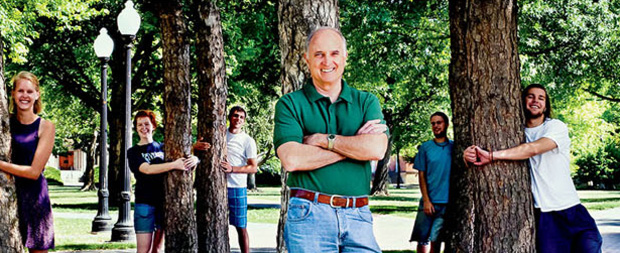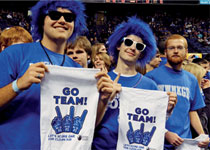By Bob Sipchen

Professor David Orr and his students, Oberlin College, June 2012. "Hope," he often tells them, "is a verb with its sleeves rolled up." | Photo by Raymundo Garza
For his part, Oberlin president Marvin Krislov treats Orr like a prize bull that he fully respects—"David is visionary, inspirational"—while keeping one hand on a high-voltage cattle prod. Both the town and the college, Krislov notes, were founded by abolitionists, and both have always embraced the sort of social change that often discomfits others. "Creating a better world is deep in Oberlin's DNA."
As we continue deeper into the campus, Orr ruminates on the patience required to navigate the inefficiencies of democracy while listening to the tick-tick-tick that says that ending our dependence on fossil fuels and squandering of resources should have happened yesterday.
We arrive at what is probably the most tangible artifact of Orr's approach to making things happen. Long before the Oberlin Project, he and his colleagues began cooking up the idea of a new environmental studies building. School administrators and directors, he says, told him they'd support the building if he raised the money—but added that he could not tap existing donors. "That left me with the Colombian drug cartel," he deadpans.
From conception, the building, completed in 2001 on a 1-acre site, was meant to be an example of what colleges and universities could aspire to if they were serious about addressing the spectrum of environmental problems that traditional buildings either cause or fail to address.
Orr brought in experts to draft plans and then opened the design process to students. The criteria: "Create no ugliness, human or ecological." The result: the Adam Joseph Lewis Environmental Center, a $7.2 million, 13,600-square-foot glass-and-steel edifice that Architect magazine called "the most important green building constructed since 1980."
That importance, in part, owes to the role the building played in jump-starting college sustainability efforts nationwide. Orr points to the surrounding garden, orchard, and artificial wetlands populated with indigenous plants and animals. Inside, Orr strokes the auditorium's compressed-wheat-straw acoustic tiles. He taps his toe on the brown slate tiles that cover a radiant, geothermal heating system. He presses his finger on a window looking into the Living Machine greenhouse, essentially an indoor wetland that processes sewage into water to flush toilets and irrigate.
As our tour continues, Orr calls out to professors and to students caught up in the stress of finals week. Ben Jones says that he was lured to attend Oberlin in 1992, in part by a poster of a globe and the words "Think one person can change the world? So do we." Jones returned a few years ago to take a job in communications and to support the project, in part because he had taken Orr's Environment and Society class and was impressed by the professor's knack for blending realism and humor to instill a "let's get it done" attitude.
"David will take you down a very dark road about significant challenges, and then just when you think you can't take any more, he'll make you laugh," Jones says. "If you talk to him long, you'll hear him say, 'Hope is a verb with its sleeves rolled up.'" Continue reading >>

Rural mothers become solar engineers.

Ditching the cubicle for a summer outdoors.

Students fight to kick coal off campus.